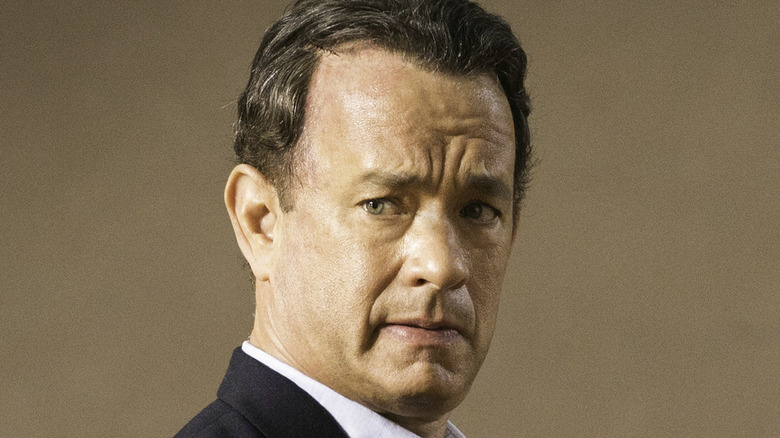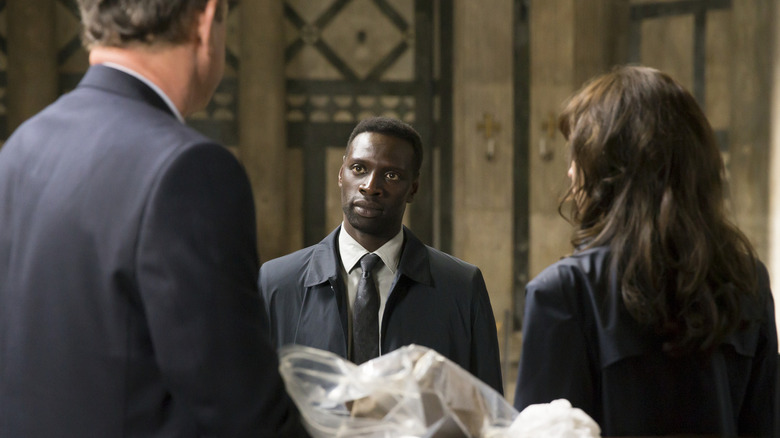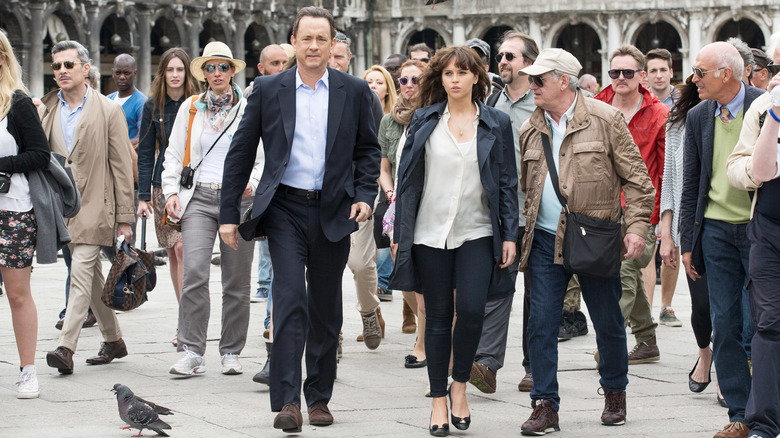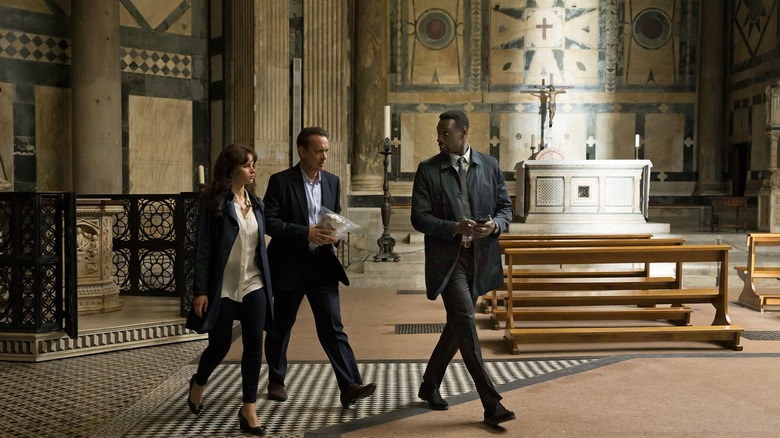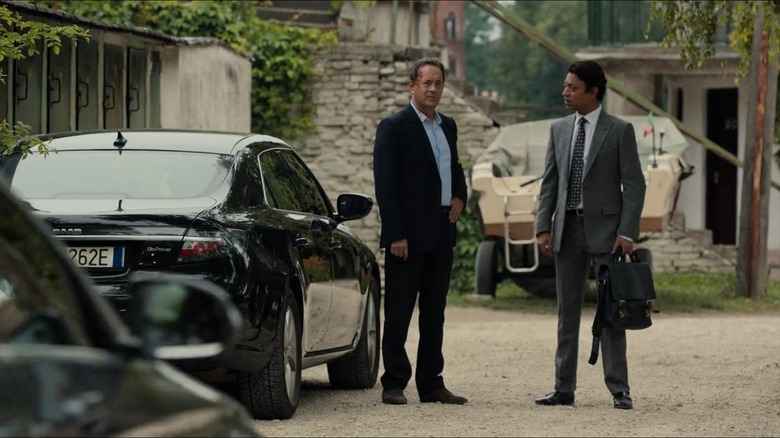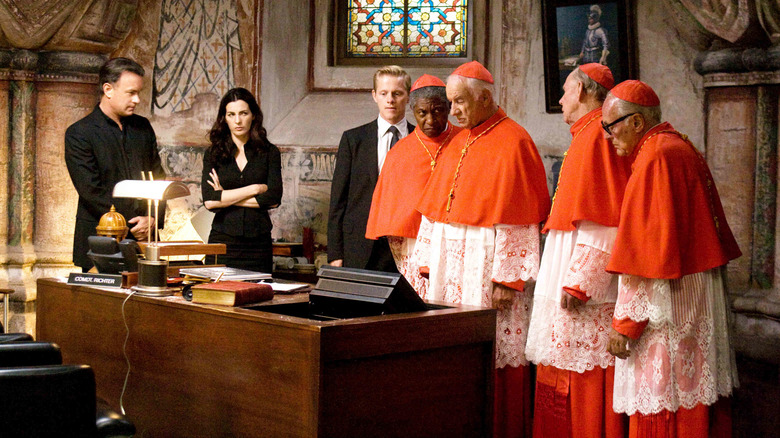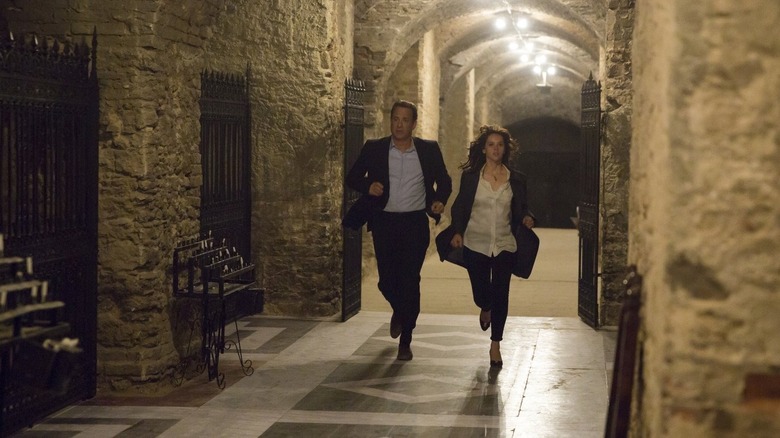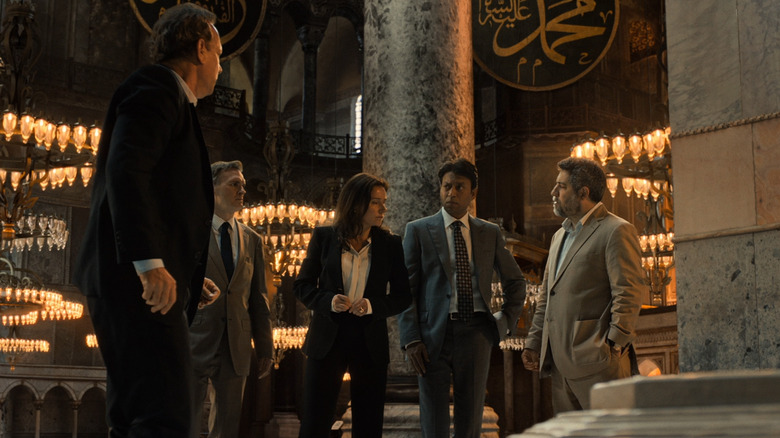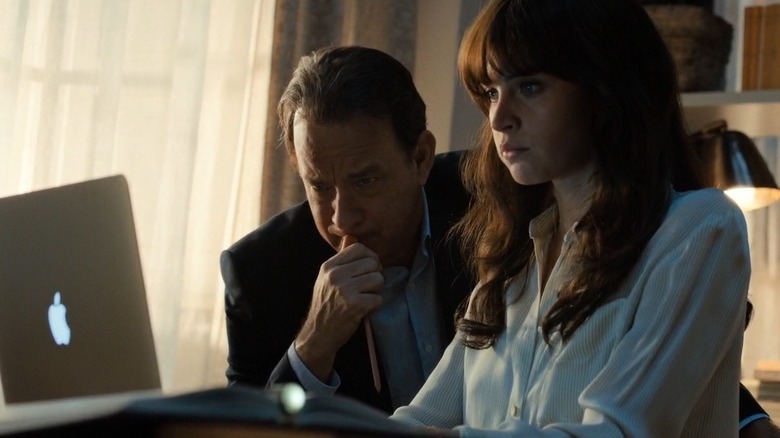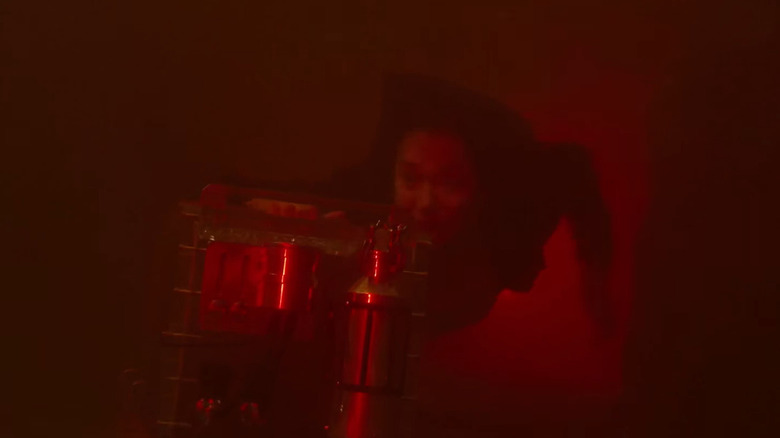Sizzling Inferno Facts That Only Major Robert Langdon Fans Will Know
Bestselling novelist Dan Brown is known for the creation of Robert Langdon, a fictional symbologist and adventurer who first came to the limelight with the 2000 novel "Angels and Demons." Hollywood soon came calling, and Langdon's adventures across Brown's book series were adapted for the big screen by Ron Howard, casting longtime friend and collaborator Tom Hanks in the Langdon role.
2016's "Inferno" was the third film in what turned out to be a trilogy of movies centered around Langdon. This time around, Hanks' character cis aught up in an international conspiracy involving secret societies, ancient artifacts, and a new danger to the world — a virus that threatens to wipe out major chunks of humanity unless Langdon and his cohorts can beat the bad guys and save the day once again.
Much like the novel on which it is based, "Inferno" feels like an old-fashioned action-thriller wrapped up in a modern package. The film did relatively decent business at the box-office considering its lack of huge action sequences and mounds of CGI, typically mandatory in modern blockbusters. Unsurprisingly, Langdon fans love unearthing mysteries, so here are a few little-known facts about "Inferno."
A real life action stunt
As with other Brown novels, "Inferno" ratchets up the tension with a series of well-placed sequences involving the main characters getting caught up in near-death experiences. To bring the authenticity of such scenes to the big screen, the film adaptation of "Inferno" was also shot on real locations instead of in front of green screens.
This led to an incident where actor Omar Sy (who plays Christophe Bouchard, an official from an international organization tasked with helping contain the spread of the virus) found himself caught up in a real life action scene. On his first few days of filming in Venice, Sy was still getting accustomed to the sets, and lost his footing near one of the canals at the location.
"On the very first shot of the movie, [Sy] accidentally fell into the canals of Venice," explained Howard on "Good Morning America" in 2016. "He was knocked into the canals of Venice by the guy with the camera."
The case of the missing mullet
The Langdon trilogy of movies are quite a departure from other Hanks efforts. Typically, the actor is best known for playing the affable everyman, and is rarely associated with action-adventure unless it's in service of a story like 2016's "Sully." So, the "Da Vinci Code" filmmakers made an effort to give Hanks a more believable, dashing action hero look with some cosmetic changes.
One such change involved giving Hanks a mullet. The odd hairstyle choice became the subject of much internet chatter when it debuted in "The Da Vinci Code." The mullet then returned in the sequel "Angels and Demons." But it is missing from "Inferno," as Langdon now has shorter hair more in line with your typical Hanks role.
"We all loved that haircut on 'Da Vinci Code,'" director Howard said in 2016 about the follicle flair. "But fans not so much, and critics worse."
So, why did they drop it for "Inferno"? "Women loved this haircut throughout the whole shoot," Howard explained. "Everywhere [Hanks] went, it was 'oh, I like his hair, wow, wow', and then, either because it's just not what Tom looks like or not what they imagined Robert Langdon looked like or something, it became this sticking point."
No longer intimidated by Langdon
Hanks is one of those rare actors who has built nearly his entire career on standalone dramas and comedies, not sequels and remakes. The "Da Vinci Code" and its two sequels would become a rare outlier in this regard.
Naturally, this means Hanks grew more familiar with Langdon over the years than his other roles.
"When we made The Da Vinci Code, I was probably intimidated by [Langdon]," Hanks said in 2016. "I was trying to constantly manifest this concept of the professor who lived alone and got called in as the expert."
Hanks said his past experience with Langdon helped him while making "Inferno," since he now had "an understanding of the way Langdon thinks, what he would do and would not do and what drives him." So instead of having to create a fresh character for "Inferno," Hanks was more interested in protecting the characterization of Langdon that had been established in the previous two movies.
Making friends with the enemy
In addition to Hanks, "Inferno" features a large international cast of distinguished actors from around the globe. One such actor is the late Irrfan Khan, who was known for his work in a number of Hollywood and Bollywood films. Khan plays the role of Harry Sims, who has an antagonistic relationship with Langdon at the start of "Inferno."
But while Sims and Langdon were at odds in the movie, behind the scenes Khan and Tom Hanks were smitten. "Here's what I hate about Irrfan Khan," Hanks jokingly told IANS (via Hindustan Times). "I always think I'm the coolest guy in the room, and everybody's hanging on to every word I say and everybody's a little intimidated to be in my presence. And then Irrfan Khan walks into the room. And he's the coolest guy in the room."
For his part, Khan told NDTV that Hanks is a "wonderful actor and amazing person." The actor also shared a personalized note that Hanks had sent to him, welcoming Khan into the "Inferno" family and expressing his happiness over them working together.
Changing the book order
The adventures of Langdon in the book series and on the big screen have never really synced up, in terms of the timeline. That's because the character was first introduced in Dan Brown's 2000 novel "Angels and Demons," a modest success. It wasn't until the sequel, "The Da Vinci Code," that the series became bestsellers across the world.
When Hollywood came calling, they did so with the intention of making a movie based on "The Da Vinci Code." After that film was a success, "Angels and Demons" became its cinematic sequel. But don't get too confused — these alternating sequels and prequels work because each Langdon book is largely a self-contained adventure — aside from the main character, there are few connections that threaten continuity.
Further complicating matters, however, is "Inferno." In the books, "Inferno" is Langdon's fourth adventure, following "The Lost Symbol." But in the movies, it is Langdon's third adventure, following "The Da Vinci Code" and "Angels and Demons." In acknowledgement, there's even a throwaway line in "Inferno" where Langdon says the Vatican hates him, a reference to the events of the previous two films.
Different from the rest
Since there are a total of three movies based on Langdon made by Hanks and Howard, "Inferno" is of course frequently compared to its predecessors. With a reported $75 million budget, the film was the least expensive to make of the trilogy; it also has the shortest run time at 121 minutes.
So, the film comes across as more tightly-paced, lean, mean and filled with more action scenes; it's the only movie of the trilogy where Langdon fights a villain. This change in tone is also reflected in the film's musical score, once again composed by the trilogy's Hans Zimmer.
"When Hans saw the movie, he said we've done something very different here, Ron," Howard said in 2016. "It is more contemporary and psychological, and we can deconstruct those Langdon themes and really use them in interesting ways, and do something cool." Zimmer's resulting effort embraces electronic tracks, contrasting the classical orchestral music.
Passing over The Lost Symbol
The Langdon series of books are some of the most widely-read novels in history. They are also ripe for movie adaptations, featuring action-packed treasure hunts in exotic locales where the protagonists are hunted by forces engaged in global conspiracies.
Yet, despite the 2009 Langdon novel "The Lost Symbol" similarly featuring plenty of the same action formula, and an intriguing mystery at its center, the novel never got adapted. As it turns out, Hanks and Howard made a decision together to pass over "The Lost Symbol," moving along instead to "Inferno."
"We actually worked on [The Lost Symbol] for a while to see if there was something [to adapt into a movie]," Hanks reveled in 2016. "We had to say that we don't quite think there is something [there] to truly hang [a movie] on." When "Inferno" hit bookshelves in 2013, Hanks and Howard decided its plot held more cinematic potential, and they went to work making it the third Langdon film.
Expanding on The Provost
In the novel "Inferno," the main characters of Langdon and Sienna Brooks are in a race against time to stop the spread of a deadly new virus. Standing in their path is a shadowy organization called "The Consortium," headed by a person known simply as The Provost. It is on direct orders of The Provost that assassins give chase to Langdon and Brooks across the novel.
The film adaptation of "Inferno" changes things up by bringing The Provost out of the shadows and giving him the name Harry Sims. Played by Irrfan Khan, this version of The Provost is tasked with helping keep the virus secure from Langdon and his allies until a certain date.
Sims differs from his book counterpart by being much more willing to get his hands dirty. In the book, The Provost prefers to leave the dirty work to his agents, and gets arrested in the end while trying to escape. But in the movie, Sims personally performs some pretty violent actions with expertise, eventually dying in the final fight.
Changing Sienna from the book
As with The Provost, the Brooks character gets a makeover for the cinematic "Inferno." In the book, Langdon first meets Sienna when he wakes up in a hospital with no memory of how he got there. Sienna is one of the doctors tending to him, ultimately helping him escape from the hospital.
For the rest of the novel, Sienna is presented as one of the few people that Langdon can trust, until it is revealed that she has been playing him all along. In truth, Sienna is a disciple (and lover) of villain Bertrand Zobrist, who has been working behind the scenes to make sure the virus gets released into the world.
When it came time for Felicity Jones to play the character in the film, some parts of Sienna's character and motivations were changed.
While the book version of the character is appalled by the plan of Zobrist (Ben Foster), in the movie Sienna is ready to sacrifice her own life to bring his plan to fruition. In the novel, Sienna succeeds in her mission, even successfully evading the authorities in the end. In the movie, Langdon and his true allies contain the spread of the virus, as Sienna dies during the climax.
A different ending
Brown's 2013 novel "Inferno" was always going to be difficult to adapt into a film. Not only does it contain mountains of exposition, centered around obscure art and complicated scientific processes, but the book ends on a massive downer when it is revealed that the villain had already succeeded in releasing a highly dangerous virus before the story even began.
So, the makers of "Inferno" decided to change it completely. In the movie, the protagonists succeed in preventing the release of the virus, designed to wipe out half of all human life — in the novel, it causes sterility in a certain percentage of the population. The film's screenwriter, David Koepp, explained the altered ending as a necessity for translating the ideas from the book into a film.
"The ending of the book, which I found really cool as a book," Koepp said in 2016, "was not something that I felt you could dramatize very well in terms of what people say and do, which is really all you have in a movie."
Koepp further pointed out that while the novel is blessed with the luxury of spending several pages expounding on the social and philosophical ramifications of letting the virus spread, the movie has to wrap up the story in a few scenes, and had to do so while avoiding heavy monologuing by the characters.
Not fondly remembered
The Langdon series of movies may be an outlier in the Hanks filmography since he isn't known for making action films, but the box-office success of "The Da Vinci Code" and "Angels and Demons" seemed to indicate that, perhaps, Hanks should consider doing more popcorn fare.
By the time "Inferno" was released, however, that magic appeared to be fading. It made the least amount of money out of the trilogy, and was also disliked by critics. In recent years, Hanks has appeared to look back on the trilogy — and particularly "Inferno" — as somewhat disappointing experiments, toyed with because of their box-office potential.
"All we were doing [with the Robert Langdon movies was] promising a diversion," the actor told The New York Times in 2022. "There's nothing wrong with good commerce, provided it is good commerce. By the time we made ['Inferno'], we proved that it wasn't such good commerce."
